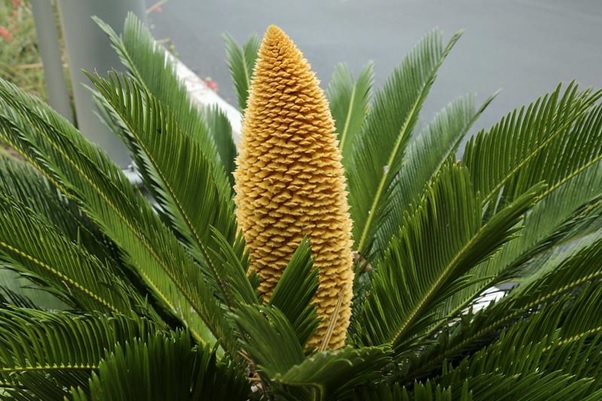The labor of caring for your plants can boost your physical health. It’s a perfect way of exercising and spending time with nature which can lessen your stress levels. You can grow beautiful plants, flowers, and delicious produce. You’ll surely benefit from gardening, whether simply looking at its beauty or consuming a freshly harvested vegetable. Admittedly, it is suitable for your overall well-being.

If you’re looking for the plants to grow in your garden, then read on below! The following information consists of facts that will help you in your gardening journey.
1. Sago Palms
Sago palms also go by its botanical name, cycas revoluta. It’s known for a smaller version of a palm tree, and it has glossy and stiff fronds. The plant is a cycad; it has been around since prehistoric times, making it one of the most ancient plants. It’s excellent to grow it indoors, although you have to be careful with pets and small children because it’s poisonous.
Cycas revoluta can tolerate drought, although it prefers soil that has a moderate amount of moisture. Touch the soil when watering, and if it feels dry, water it immediately but never make the ground soggy. Suppose you’ve noticed that the plant isn’t growing that well, then reduce the water you give to the plant. It can grow in either full sunlight or partial shade, making it the perfect plant for beginners.
Before purchasing your sago palms, you must do your research first. Visit websites like GardenersPath.com to learn how best to take care of the plant in detail and the different tips to remember.
2. Tomato
Solanum Lycopersicum, commonly called tomatoes, comes in yellow, scarlet, purple, green, and red. They vary in shape from oval, elongated, almost spherical, and almost resembling a pear. Every Solanum Lycopersicum contains jelly-like pulp with tiny seeds.
When caring for your tomatoes, ensure that you water them early in the morning to have enough moisture to last through a hot day. When first planting the plant, water it generously to get enough nutrients from the water. During the growing season, water your tomatoes for about two inches every week.
Solanum Lycopersicum is the primary dietary source of the antioxidant lycopene, contributing to numerous health benefits, including improved heart health, sun protection, and many more. It is also a great source of countless helpful nutrients like potassium, folate, Vitamin C, and K.
You can use tomatoes in dishes like bruschetta, Caprese salad, tomato sauce, burgers, pasta, and many more. Additionally, you can also see it in the cosmetics world because of its ability to hydrate, brighten and clarify skin. It’s in products like toner, face oil, mud mask, lip therapy, cleanser, and many more. Solanum Lycopersicum can also be used as a dietary supplement.
3. Eggplant
Eggplant’s botanical name is Solanum melongena. You might associate eggplant with the deep color purple. Still, it has other varieties in color, such as pale purple or white. In general, its interior is cream-colored or white with seeds inside. White eggplant varieties tend to be small, but their skins are tough. It has a mild and lightly sweet taste.
Eggplants are rich in numerous nutrients, antioxidants, aid you in weight loss, and they’re easy to add to your meal and diet. You can utilize an eggplant by frying it, baking it, sauteeing it with numerous sauces, e.g., garlic sauce, bulgogi sauce, Italian sauce.
4. Blackberries
It’s commonly called blackberries, but you can call it by its scientific name, rubus. This plant has biennial stems that are covered with prickles. It usually has three or five leaves that are oval and coarsely toothed. The fruit is colored black with a sweet taste. Blackberries bloom depending on where you are situated; they can bloom in the middle of April up until the start of May. It can also begin to bloom in much cooler climates at the end of May.
One hundred grams of fruit contains only 43 calories. You can munch on these rather than junk food for a healthier option, especially if you’re on a diet. Rubus is high on antioxidants, and it can help with various health concerns. It also contains Vitamin C, and it’s high in fiber and manganese.
5. Phlox
Phlox are ideal for sunny places. They are tall, and their star-shaped flowers come in purple, pink, blue, lavender, or white. It blooms during spring through summer, and they’re hassle-free to take care of. Depending on the species you purchase, this plant can grow up to six to 48 inches tall and 12 to 24 inches wide.
The phlox’s soil must be moist but well-draining. Before planting, if your soil doesn’t work well with water, add some compost to its soil. Give the plant plenty of room so that the air will circulate the plant, especially in humid areas.
Takeaway
Gardening has little to no disadvantages, but it has numerous advantages. It can lessen your carbon footprint, and by growing plants, you are contributing to the environment and your health. Plants bring happy energy and vitamins to your home and stomach. Consider the five plants mentioned above to enjoy their numerous benefits.
 World inside pictures Collect and share the best ideas that make our life easier
World inside pictures Collect and share the best ideas that make our life easier






